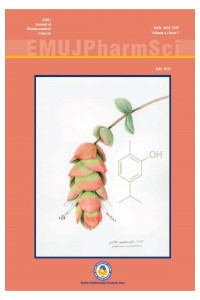THE INVESTIGATION OF THE INTERACTION OF SEVERAL ANTIPSYCHOTIC DRUGS WITH HUMAN CHOLINESTERASE ENZYMES
THE INVESTIGATION OF THE INTERACTION OF SEVERAL ANTIPSYCHOTIC DRUGS WITH HUMAN CHOLINESTERASE ENZYMES
___
- Cummings, J. L. (2000). Cholinesterase inhibitors: A new class of psychotropic compounds. Am J Pscyhiat, 157(January), 4–15.
- Darvesh, S., Macdonald, I. R., & Martin, E. (2013). Selectivity of phenothiazine cholinesterase inhibitors for neurotransmitter systems. Bioorg Med Chem LettT, 23(13), 3822–3825.
- Darvesh, S., McDonald, R. S., Penwell, A., Conrad, S., Darvesh, K. V., Mataija, D., … Martin, E. (2005). Structure-activity relationships for inhibition of human cholinesterases by alkyl amide phenothiazine derivatives. Bioorg Med Chem, 13(1), 211–222.
- Darvesh, S., Pottie, I. R., Darvesh, K. V., McDonald, R. S., Walsh, R., Conrad, S., … Martin, E. (2010). Differential binding of phenothiazine urea derivatives to wild-type human cholinesterases and butyrylcholinesterase mutants. Bioorg Med Chem, 18(6), 2232–2244.
- Ellman, G. L., Courtney, K. D., Andres, V., & Featherstone, R. M. (1961). A new and rapid colorimetric determination of acetylcholinesterase activity. Biochem Pharmacol, 7(2), 88–95.
- Ercetin, T., Senol, F. S., Erdogan Orhan, I., & Toker, G. (2012). Comparative assessment of antioxidant and cholinesterase inhibitory properties of the marigold extracts from Calendula arvensis L. and Calendula officinalis L. Ind Crop Prod, 36(1), 203–208.
- Extoxnet. (1993). Cholinesterase Inhibition. Retrieved December 1, 2016, from http://pmep.cce.cornell.edu/profiles/extoxnet/TIB/cholinesterase.html
- Gulcan, H. O., Unlu, S., Esiringu, İ., Ercetin, T., Sahin, Y., Oz, D., & Sahin, M. F. (2014). Design, synthesis and biological evaluation of novel 6H-benzo[c]chromen-6-one, and 7,8,9,10-tetrahydrobenzo[c]chromen-6-one derivatives as potential cholinesterase inhibitors. Bioorg Med Chem, 22(19), 5141–5154.
- Jaszczyszyn, A., Ga̧siorowski, K., Świa̧tek, P., Malinka, W., Cieślik-Boczula, K., Petrus, J., & CzarnikMatusewicz, B. (2012). Chemical structure of phenothiazines and their biological activity. Pharmacol Rep, 64(1), 16–23.
- Mayoclinic. (2016). Phenothiazine (Oral Route, Parenteral Route, Rectal Route) Description and Brand Names - Mayo Clinic. Retrieved November 1, 2016, from http://www.mayoclinic.org/drugssupplements/phenothiazine-oral-route-parenteral-route-rectal-route/description/drg-20070394
- Nasello, A. G., Gidali, D., & Felicio, L. F. (2003). A comparative study of the anticholinesterase activity of several antipsychotic agents. Pharmacol Biochem Be, 75(4), 895–901.
- Pope, C., Karanth, S., & Liu, J. (2005). Pharmacology and toxicology of cholinesterase inhibitors: Uses and misuses of a common mechanism of action. Environ Toxicol Phar, 19(3), 433–446.
- Rahman, A., & Choudhary, M. I. (2014). Drug Design and Discovery in Alzheimer’s Disease. Drug Design and Discovery in Alzheimer’s Disease. https://doi.org/10.1016/B978-0-12-803959-5.50018-0 Sims, J. (1995). The extrapyramidal effects of phenothiazines on patients. NURS TIMES. Retrieved from http://www.ncbi.nlm.nih.gov/pubmed/7501500
- Sudeshna, G., & Parimal, K. (2010). Multiple non-psychiatric effects of phenothiazines: A review.Eue J Pharmacol, 648(1–3), 6–14.
- ISSN: 2651-3587
- Başlangıç: 2018
- Yayıncı: Doğu Akdeniz Üniversitesi
REVIEW ON PATIENT SATISFACTION IN PHARMACY SERVICES
Canan GULCAN, Aransiola DAMİLOLA A
Sonia SANAJOU, Shalaleh NOURHASHEMİ, Amirhossein FALLAH, Tugba ERCETİN, Mustafa Fethi SAHİN, Hayrettin Ozan GULCAN
HONEY PLANTS OF GUZELYURT MORPHOU IN NORTH CYPRUS
Çağın KORKMAZER, F. Neriman ÖZHATAY
PROBIOTICS AND THEIR USES IN CLINICAL PRACTICE – AN OVERVIEW
Mehmet İLKTAÇ, Hanin TANJARA, Sultan ÖĞMEN, Gülden ÇELİK
USE OF ANALGESICS AND REYE’S SYNDROME
EVALUATION OF SPORTS PHARMACY IN TURKEY AND NORTH CYPRUS AS A NEW IMPORTANT FIELD FOR PHARMACISTS
Nimet Ceren ÜRESİN, Somer HELVACI, Gönül ŞAHİN
ORALLY DISINTEGRATING TABLETS: A SHORT REVIEW
Dilek Emine OZYILMAZ, Leyla Beba POZHARANİ, Mustafa ALHADİ, Adama Emmanuella OCHANYA
